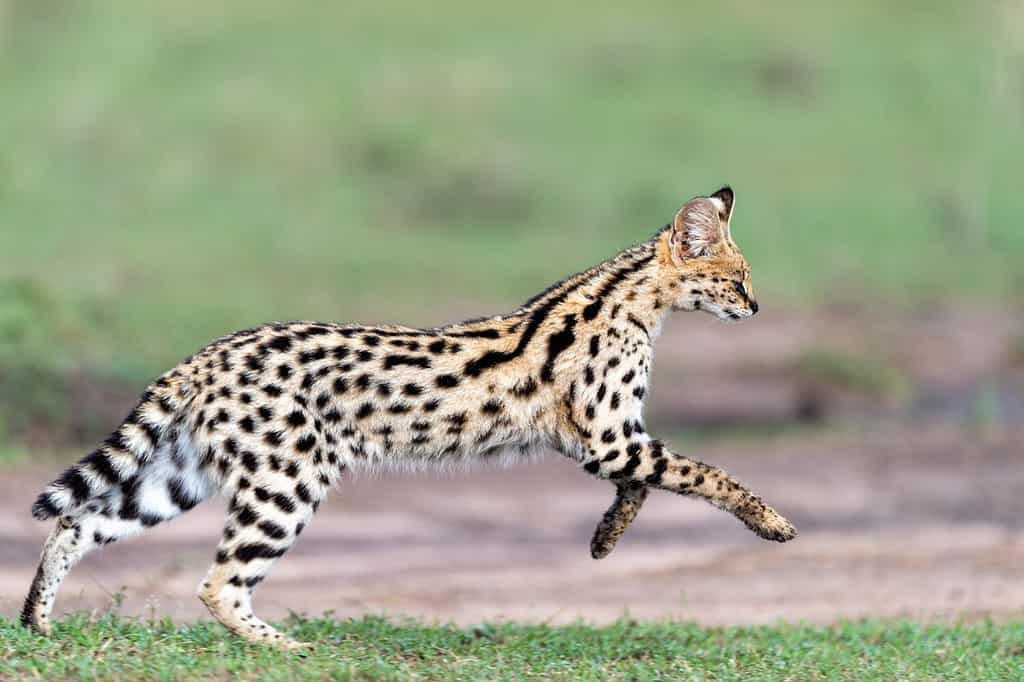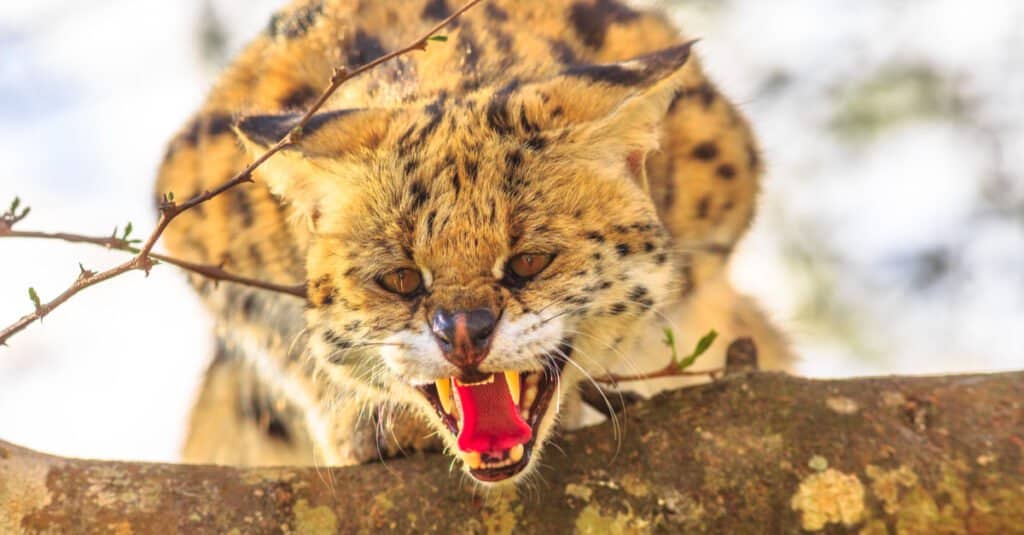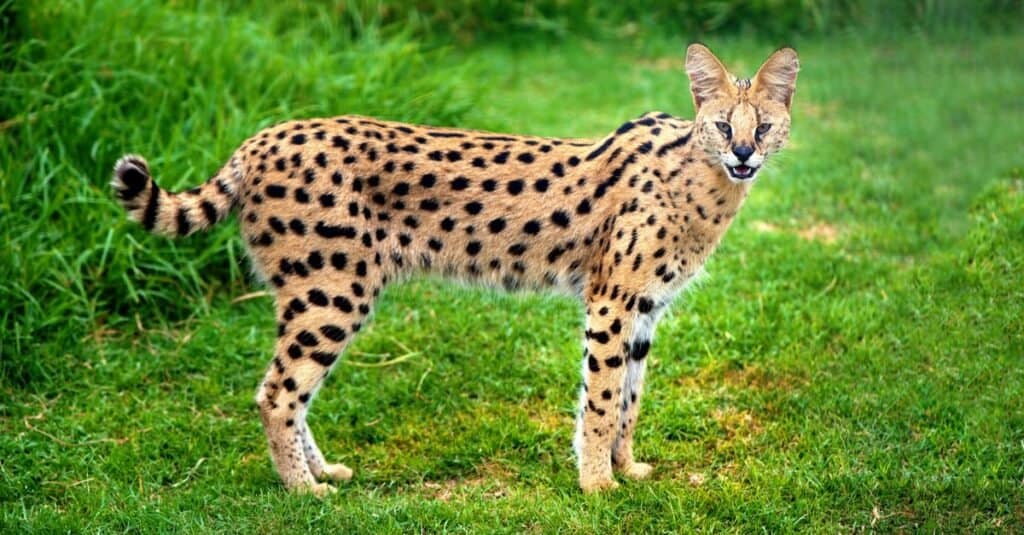In the vast grasslands of Africa, a mesmerizing and formidable feline gracefully strides on long, slender legs through the savannah. The serval cat, a creature of both grace and cunning, possesses a unique and alluring beauty matched only by its hidden strength. Beneath its smooth coat, powerful muscles tense, ready to unleash lightning-fast bursts of speed and unbelievably high leaps. But just how big are serval cats?
What is a Serval Cat?

Some serval cats have been recorded jumping over 9 feet off the ground!
©PRESSLAB/Shutterstock.com
Serval cats (Leptailurus serval), also known as African servals, are small wild cats native to Africa. Although they may look like extra stunning housecats, these animals are wild and skilled hunters. They use their excellent sense of hearing to find their food, often leaping over 6.5 feet off the ground when they hunt!
Serval cats have long and slender bodies. Their golden or tawny fur coats have black stripes and spots, and their short tails have black tips. They have elongated toes and incredibly long legs — longer than any other cat relative to body size! In fact, the serval has the affectionate nickname of “giraffe cat” due to its extra-long neck and legs. Servals also have small heads and extra-large ears, which they use to locate their prey.
How Big Are Servals When They Are Born?

Serval kittens are blind when they are born.
©Roselynne/Shutterstock.com
Female servals are pregnant for around 70 days and then birth to one to five kittens. These tiny kittens only weigh 9 ounces — less than a can of soda! Serval kittens lack the patterns of adult cats and instead have grayish hair that is soft and wooly. Their eyes are sealed shut for the first week or two of life, and they rely solely on their mothers to care for them.
When they are around four weeks old, serval kittens begin to eat solid foods. They also begin going with their mother on her hunts, and by six months old they can hunt for themselves. At this time, they also develop their permanent teeth. This allows them to hunt and consume prey more easily on their own. Young serval cats stay with their mother until they are around 12 months old. However, some will stick around in their mother’s territory until they are 18 to 24 months old.
Serval Progression: Growth Chart by Age
| Age | Weight |
|---|---|
| Newborn | 9 ounces (~0.5 pounds) |
| One week | 15 to 18 ounces |
| One month | 1 to 3 pounds |
| Two months | 3 to 5 pounds |
| Three months | 5 to 8 pounds |
| Four months | 8 to 12 pounds |
| Five months | 12 to 14 pounds |
| Six months | 14 to 25 pounds |
| Seven months | 15 to 28 pounds |
| Eight months | 16 to 30 pounds |
| Nine months | 16 to 33 pounds |
| 10 months | 17 to 35 pounds |
| 11 months | 18 to 36 pounds |
| 12 months | 18 to 40 pounds |
These measurements are approximate and can vary depending on many different factors, like genetics, nutrition, environment, etc. Each individual cat may vary slightly, and males are typically larger than females. Like all cats, servals grow and develop very quickly during the first few months of life, and then gradually slow down as they reach adulthood.
How Big Are Fully Grown Serval Cats?

Serval cats can run up to 50 miles per hour!
©Reto Buehler/Shutterstock.com
Serval cats reach sexual maturity when they are around 12 to 25 months old. In the wild, they can live around 10 years, while in captivity they can live up to 20 years. As fully grown adults, serval cats stand 21 to 24 inches tall at the shoulder and measure 26 to 39 inches long. Adult servals weigh 18 to 40 pounds with 12-inch-long tails.
Serval Cats as Pets

Serval cats are wild animals and should not be kept as domestic pets.
©Benny Marty/Shutterstock.com
The Ancient Egyptians kept serval cats in captivity and often included them in their art. About 100 years ago a breeding stock of serval cats came to the United States, and today there are serval cats several generations removed from their African ancestors. However, these wild cats are not fully domesticated. They are considered “exotic” animals — even if they are bred domestically.
Although some people have kept serval cats as pets, there are strict ownership restrictions under exotic animal laws. So, if you are seeking to own a serval cat, be sure to check your local laws thoroughly before doing so. Even if you are well-prepared and have everything you may need to care for a serval cat, it may still be illegal in your area.
Servals are much too large and active to safely live inside a home. They require expansive and secure outdoor enclosures. In the wild, they would be roaming several miles each day, and in captivity, they need lots of space to expend their high levels of energy. In addition, serval cat enclosures not only need secure walls but also a secure top — remember, these incredible wild cats can leap over 6 feet off the ground!
More recently, breeders have started crossing serval cats with domestic cats, resulting in hybrid breeds like the savannah cat. While these hybrids retain the wild beauty of the serval cat, they also inherit many familiar traits from domestic cats. However, hybrid wild cats are still very different from domestic cats. They require special care and attention due to their wild ancestry, so be sure to do your research before bringing one into your home.
Common Health Issues in Serval Cats

The bite force of a serval cat is 172 Newtons, while the bite force of a domestic cat is 56 Newtons.
©Howard Klaaste/Shutterstock.com
Servals are generally pretty healthy. However, they are curious animals and opportunistic predators and have a tendency to swallow foreign objects. These can get stuck, cause damage to their throats, or cause choking. In addition, foreign objects are very difficult to pass, and they can cause pain, and discomfort, and even lead to surgery.
As wild cats, servals need a wide variety in their diet. In the wild, they consume many different prey items, such as fish, birds, insects, reptiles, hyraxes, rodents, frogs, and hares. However, servals typically choose smaller animals. In fact, a single cat can consume 4,000 rodents each year! They prefer to hunt and consume live food and commonly play with it before eating it.
The photo featured at the top of this post is © PRESSLAB/Shutterstock.com
Thank you for reading! Have some feedback for us? Contact the AZ Animals editorial team.






